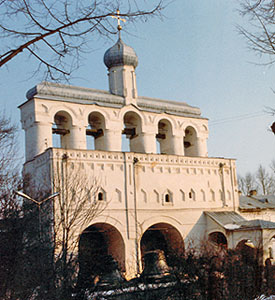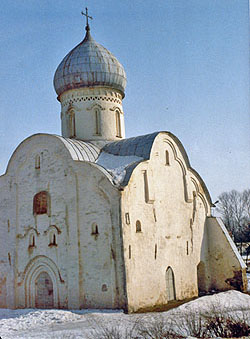With the disintegration of the Kyivan state, different political centers emerged in Russia: Kyiv, Vladimir, Moscow and Novgorod (all to the north of Kyiv). But Russian society still faced external pressures. From the West, the Teutonic Knights and the Swedes were moving eastwards into the Baltic coast.
The Teutonic knights were a crusading order of the church formed in the 1100s. (Is that not a weird statement!) The Knights had moved to Poland and accepted an imperial, and papal, mandate to conquer the Prussians, some still-pagan peoples living on the shores of the Baltic Sea. The conquest of the Prussians lasted decades and was accomplished with a lot of violence (in the name of God, of course). Most of the Prussians were either exterminated or enslaved; they were also technically converted to Christianity. Having accomplished the subjugation of the Prussians, the Knights turned their attention further eastward in the direction of northwestern Russia.
The key figure in defeating both the Swedes and the Teutonic Knights was Prince Aleksandr Iaroslavich "Nevskii" (1220-1263). Nevskii grew up in Vladimir, but in 1236 he became prince of Novgorod with the task of leading the city's army to defend the city. (How old was he!). In 1240, he led the army into battle against the Swedes near the rivers Izhora and Neva and defeated the Swedish army on 15 July 1240. (For this he became known as "Nevskii.") Soon thereafter, the Teutonic Knights threatened the city. Nevskii returned from his exile--No need to go into details--and gathered an army again. On 5 April 1242 Nevskii faced the enemy and defeated the Teutonic Knights in the Battle on Lake Peipus ("Battle on the Ice") when the thawing ice on the lake cracked under the weight of the heavily armored knights on horseback. The invasions of Russia from the west and the north had been stopped thanks to Nevskii who later became Grand Prince of Russia. After his death, he was initially buried in Vladimir (later moved). The Russian Orthodox Church also recognized Nevskii as a saint in 1547. Take some time and watch Sergei Eisenstein's 1938 movie on Aleksandr Nevskii, one of my favorites, with Sergei Prokofiev's score (unbelievable music). While far from being accurate historically, the movie is still a must see (and consider the year in which it was released).
While Russia had been able to deal with the threats from the north and west, i.e., the Swedes and the Teutonic knights, the real danger came from the east in the form of the Mongols (covered in the next unit).
Some recommended books
- Robert Crummey, The Formation of Muscovy, 1304-1613 (1987)
- Ian Grey, Ivan III and the Unification of Russia (1964)
- John Fennell, The Emergence of Moscow, 1304-59 (1968)
- Viktor Lazarev, Moscow School of Icon Painting (1980)
Some recommended websites
- There were once one or more lectures by the late Professor Michael Boro Petrovich (University of Wisconsin) relevant to this unit available on the web. I am hoping that they will reappear one day. If you are really interested, then you can use this link to search on the Wayback machine for those lectures. You can then figure out how to play the audio.
- Life in the Russian Middle Ages by Masha Holl; see also her Historical Costumes from Medieval Russia
- On Russian icons, see Ikons: Windows into Heaven and Icon Painting, which both include explanations. Orthodox Icons has links to images of specific icons.
- Muscovite Period (Excerpts from Glenn Curtiss, Russia: A Country Study, 1996)
- The Xenophile historian has some remarks about medieval Russia. See his sections on Alexander Nevsky and the Golden Horde, Lithuania, The Rise of Muscovy and Ivan the Great.
- A Glimpse into History, covers the history of Moscow to the end of the sixteenth century.
- For examples of medieval Russian architecture, see Muscovite Kremlin, Lord Novgorod the Great or Pskov
- The Novgorod Chronicle: Selected Annals
- With regard to the Russian Orthodox Church, find some simple explanations of Features and Practices of the Russian Orthodox Church; read some commentary on Russian Church Architecture (but no images).

